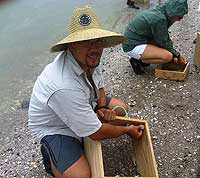 Dr Matthew Pawley sieving sand for
Dr Matthew Pawley sieving sand forshellfish samples at Umupuia Beach
near Maraetai, Auckland, this week.
Twelve popular shellfish gathering beaches in Auckland, Bay of Plenty, Northland and Waikato incldung Raglan and Aotea are being surveyed to see whether current levels of cockle, pipi and tuatua harvesting are ecologically sustainable.
Under contract to the Ministry of Fisheries, biologist and statistician Dr Matthew Pawley from the University’s Institute of Information and Mathematical Studies at Albany, is collecting, counting and measuring the shellfish.
Two of the beaches are currently closed to shellfish gathering because of concerns about the stocks. If the survey reveals numbers are too low, other beaches may be closed to allow the shellfish to repopulate. Estimates will be based on the ministry’s survey figures from 2000 to 2005.
Work began this week with a team of volunteers at Umupuia beach, near Maraetai. Over the next eight weeks, the survey will cover Te Haumi beach in the Bay of Islands, Whangateau estuary north of Auckland, Cockle Bay, Mill Bay, Okoromai Bay in Auckland, Aotea and Raglan beaches in Waikato, and Otumoetai, Waiotahi, Little Waihi and Ohiwa estuary in the Bay of Plenty.
Dr Pawley has been involved in previous shellfish monitoring surveys for the ministry. He is using mathematics and computer software rather than microscopes to analyse data so he can estimate and document changes in the abundance of shellfish. His role is to investigate rather than determine the specific causes of population change however.
“It’s very important to have some idea of how these populations vary from year to year when determining whether or not a beach should be closed to harvesting,” says Dr Pawley. “Although the main cause of a shellfish population decline might be due to recreational harvesting, we don’t actually determine this. The ministry’s approach is that if the population has been significantly reduced, it probably makes sense to close the beach to harvesting.”
The size of the areas surveyed will depend on the size of the beach. “In some beaches it may encompass 900m by 400m, with samples taken at a point every 50m by 50m. Other beaches have a much larger or smaller survey extent and the sample spacing will vary depending on the variability of the shellfish population.
“This project aims to determine the population characteristics, such as the number, distribution of sizes and spatial distribution of these shellfish species at beaches that are already closed to shellfish gathering – such as Umupuia and Cockle Bay – or may in the future be closed because of pressure from heavyharvesting.”
He has had a “terrific response” from local iwi consulted prior to the surveying. “Local knowledge has been very important in determining where to sample within the beach or harbour. In order to build a robust monitoring programme, it’s useful to know more than where the shellfish are now, but also where they were in the past – which may indicate where they will be in the future – and also how harvesting pressure has changed over time”.
